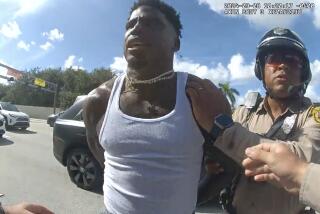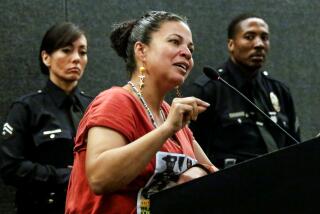Koon Quizzed on Accuracy of Report on King Beating
- Share via
SIMI VALLEY — Reading slowly from Sgt. Stacey C. Koon’s initial report of the Rodney G. King beating, prosecutors attempted Friday to prove that the police supervisor tried to conceal the full extent of injuries that King received from officers’ baton blows and kicks.
During his second day on the witness stand, Koon was quizzed about his sergeant’s daily log, in which he wrote on the day of the beating that King was under the influence of PCP and suffered only facial cuts and a split lip.
Medical authorities at Pacifica Hospital have testified that King suffered numerous cuts and bruises on his head and face, and Koon conceded Friday during the cross-examination that King also had broken bones in his cheek and leg.
The testimony of the 41-year-old officer, which continued for about 2 1/2 hours Friday, is considered critical because Koon and Officer Laurence M. Powell are not only charged with excessive force but with filing false police reports. They and the other two officers charged in the beating, Timothy E. Wind and Theodore J. Briseno, have pleaded not guilty.
Koon, the first officer charged in the assault to publicly describe what happened March 3, 1991, said his log is an accurate account of the incident in Lake View Terrace.
“I would believe the reader of this document would understand the totality of the circumstances,” he said. “And that is what I was trying to convey to the reader.”
But Deputy Dist. Atty. Alan Yochelson, leading Koon slowly through the two-page log, noted its inconsistencies with testimony and what can be seen on a videotape of the beating incident:
* Koon wrote in his report that California Highway Patrol officers, who chased King’s Hyundai just before the beating, asked the Los Angeles Police Department to “take over the pursuit.” But Koon said during the cross-examination that there was no official notification that the CHP had dropped out of the pursuit.
* Koon wrote that he “immediately observed that the suspect was under the influence of PCP,” although medical authorities have testified that tests showed no trace of the drug in King’s system.
* Koon wrote that his electric stun gun was “going the entire time,” but he testified that the Taser only operates for 15 seconds at a time and that the beating lasted about 81 seconds.
* In his log, Koon described his officers’ blows to King as “jabs.” But, on the stand, he said: “I do not see any jabs on the videotape.”
Koon also testified that Powell, accused of delivering a majority of the 56 baton blows, “was exasperated. He was panicked. He was fearful.”
At one point, the normally calm Koon appeared slightly overcome with emotion when his attorney, Darryl Mounger, asked what went through his mind when he stopped CHP Officer Melanie Singer from approaching King with her gun drawn at the scene.
“I had a flashback to when I was in the Police Academy,” Koon recalled, saying that he had been shown a photograph from the morgue of “four CHP officers in uniform on slabs, all dead from a shooting.”
While insisting that the incident was justified, Koon described the King beating as the worst he has seen during his 16-year career as a Los Angeles police officer. “I have not seen anything as violent as this,” he said.
In another development Friday, Wind’s attorney, Paul DePasquale, filed legal papers asking Judge Stanley M. Weisberg to allow him to present testimony impugning King’s character. Weisberg has yet to rule on the motion.
DePasquale outlined a series of six alleged crimes that he said involved King before the assault in Lake View Terrace, including a shooting two weeks before the beating.
The lawyer said he can present a witness who will say King shot her in the back during a video store robbery, although authorities investigated that shooting last year and declined to file charges against King because of insufficient evidence.
DePasquale said the alleged crimes demonstrate a pattern of violent and aggressive behavior that King also displayed on the night of the beating.
“The evidence of past conduct is clearly relevant to show that Rodney King acted ‘in character’ on the night in question here,” DePasquale said.
The alleged crimes include a June, 1983, incident in which King allegedly aimed his car at his girlfriend; a November, 1989, assault at a Monterey Park market for which King was convicted and sent to prison, and a May, 1991, altercation in which King allegedly tried to run over a Los Angeles police officer attempting to arrest him for solicitation of a transvestite prostitute. In the latter case, authorities again declined to file charges against King.
King has not testified in the trial and it is unclear whether he will take the stand. But his attorney, Steven A. Lerman, who is attending the trial, said in an interview outside the courtroom that DePasquale’s assertions are “nonsense.”
“The issue isn’t Mr. King’s character, but rather the obvious propensity for violence that Powell, Wind, Koon and Briseno displayed,” Lerman said. “It’s obviously a desperate attempt to confuse the jury and direct their attention away from the wrongful conduct of the defendants.”
After Koon testified Friday morning, Mounger called two officers who were bystanders on the night of the beating--seven-year veteran Joseph Napolitano and Officer Ingrid Larson, who was a probationary officer out of the Police Academy only five days at the time of the beating.
Napolitano testified that he thought King was under the influence of PCP because he seemed impervious to the Taser that Koon had used and because he was “very rigid and tense when handcuffed, and I felt he was trying to resist us.”
Napolitano, among five officers who handcuffed and hogtied King, said he asked for a second pair of handcuffs because “he was a very big person, and I had formed the opinion in my mind that he was on PCP.”
Medical tests just after the incident determined that King had no drugs in his system, although he was legally drunk.
During his training, Napolitano said, he had heard that people under the influence of PCP could break their handcuffs.
He also testified that although he saw King on his hands and knees, apparently trying to get up while being struck with batons, he never saw the motorist strike, kick or otherwise attack officers.
Mounger is expected to continue his defense of Koon on Monday by calling more bystanders and by calling three experts, Elizabeth Loftus, a nationally recognized specialist on witness identification, and Charlie Duke and Bob Michel, experts on the use of force in law enforcement.
More to Read
Sign up for Essential California
The most important California stories and recommendations in your inbox every morning.
You may occasionally receive promotional content from the Los Angeles Times.














